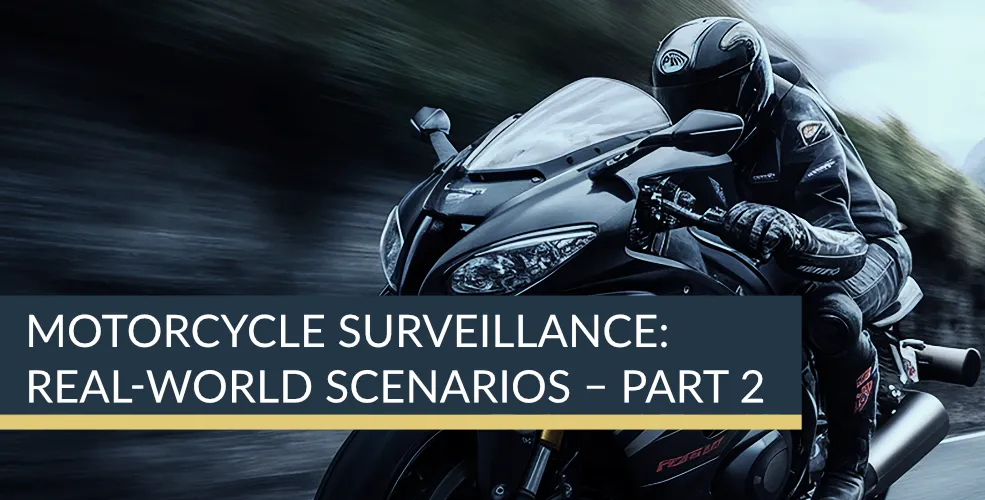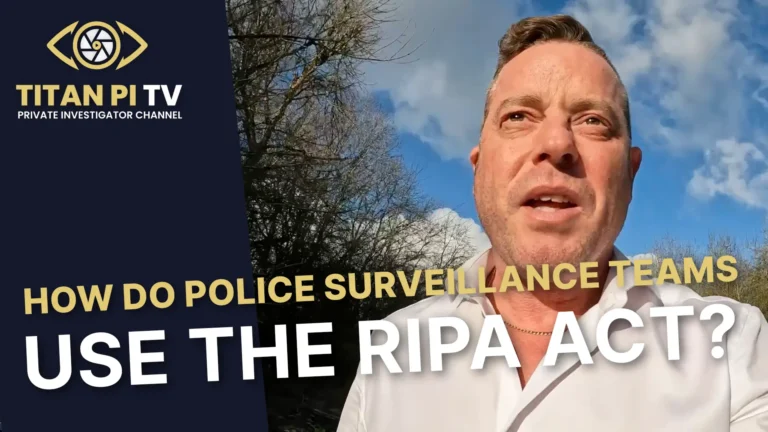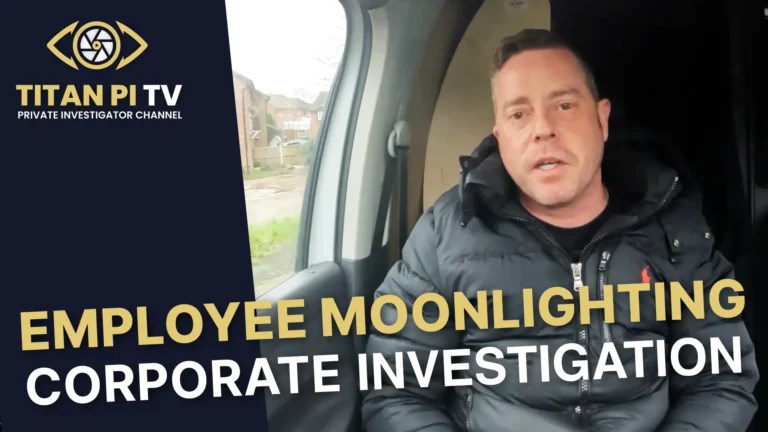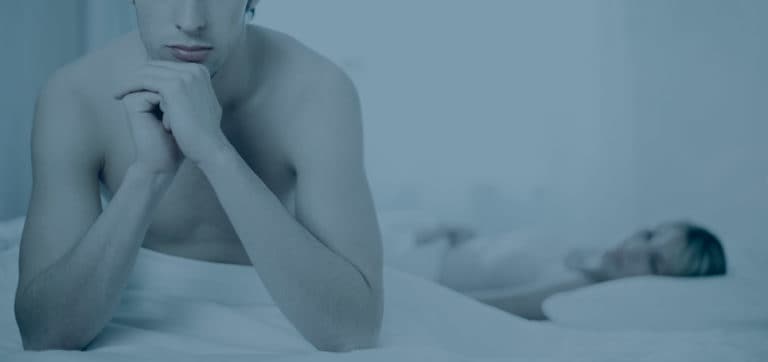Motorcycle Surveillance: Real-World Scenarios Part 2
In the dynamic and fast-paced realm of private surveillance, motorcycle units offer unparalleled agility and versatility, particularly in urban settings. Their ability to adapt to unpredictable conditions and maintain visual contact with subjects is a testament to the skill and precision of the operatives who ride them. In this post, we delve deeper into five real-world scenarios, illustrating how motorcycle surveillance teams overcome challenges to ensure successful operations.
Scenario Breakdown
1. Entering the Roundabout: Anticipation and Agility
Roundabouts are often challenging environments for surveillance teams. Traffic is constantly in flux, and maintaining visual contact with a subject requires a combination of strategy and quick reflexes. In this scenario, the subject vehicle approaches a busy roundabout, and the motorcycle unit—the “eyeball vehicle”—positions itself advantageously to monitor the situation.
The subject takes the third exit, momentarily disappearing from view. While this may seem like a setback, the motorcycle unit demonstrates its agility by quickly navigating the roundabout and re-establishing visual contact. This scenario highlights the importance of anticipatory driving: the rider must predict the subject’s likely route and adjust accordingly, minimising the time the subject is out of sight.
Such moments are where the unique advantages of motorcycles shine. Unlike cars, which may struggle with the stop-start nature of heavy roundabout traffic, a motorcycle can manoeuvre through gaps, ensuring it remains effective in its role.
2. Navigating Traffic Lights: Precision Timing
Traffic lights are another frequent obstacle in urban surveillance operations. In this scenario, the motorcycle unit approaches a red light. Unlike vehicles in government surveillance, which might bend traffic rules in controlled operations, private motorcycle surveillance adheres strictly to the highway code. Waiting at the light requires patience and composure, as losing visual contact at this juncture could jeopardise the operation.
When the light turns green, the motorcycle unit accelerates smoothly, quickly catching up to the subject vehicle. This scenario demonstrates the importance of precise timing and measured decision-making. The rider must strike a balance between urgency and subtlety, ensuring their actions do not draw unwanted attention. These moments often require advanced riding skills, as the ability to navigate urban traffic safely and efficiently is critical to the operation’s success.
3. Traffic Challenges: Mastering Congestion
Urban environments frequently present the challenge of heavy congestion, with lanes narrowing and vehicles vying for space. For motorcycle units, such conditions play to their strengths. In this scenario, the subject vehicle enters a crowded high street during rush hour. While other surveillance vehicles struggle to maintain proximity, the motorcycle unit seamlessly weaves through gaps, maintaining close yet discreet contact.
This adaptability is what makes motorcycles indispensable in private surveillance. Their ability to manoeuvre through tight spaces allows them to track subjects even in the most challenging conditions. Moreover, the rider’s skill in remaining inconspicuous while navigating through traffic is crucial—drawing attention to oneself can risk compromising the operation.
In addition to physical dexterity, this scenario underscores the psychological aspects of motorcycle surveillance. The rider must remain calm and composed amidst the chaos of congested traffic, making split-second decisions that ensure both safety and operational success.
4. Communication is Key: Staying Connected
Effective communication is the backbone of any successful surveillance operation. In this scenario, the motorcycle unit plays a pivotal role as the “eyes on the ground,” relaying critical updates to the surveillance team. While tracking the subject vehicle, the motorcycle unit uses clear and concise radio communication to inform the team of the subject’s direction, speed, and any potential deviations.
For example, when the subject unexpectedly turns into a side street, the motorcycle unit immediately informs the team, allowing other vehicles in the convoy to reposition accordingly. This scenario highlights the importance of teamwork in surveillance. The motorcycle unit’s ability to stay connected ensures that the operation runs smoothly, with all team members working in synchronisation to maintain oversight of the subject.
Modern surveillance teams often rely on encrypted communication devices, ensuring that their transmissions remain secure. For the motorcycle unit, the challenge lies in managing these communications while focusing on the demanding task of riding. This requires not only technical proficiency but also a deep understanding of team dynamics and operational priorities.
5. Final Monitoring Phase: Persistence Pays Off
The final scenario illustrates the critical role of persistence in motorcycle surveillance. As the operation nears its conclusion, the subject vehicle unexpectedly diverts onto a less-travelled route. Such moments demand quick thinking and adaptability. The motorcycle unit, having briefly lost sight of the subject, takes a calculated route adjustment and regains visual contact within minutes.
This scenario underscores the importance of tenacity and resilience in surveillance work. Losing sight of a subject can feel like a setback, but experienced operatives understand that it’s often a temporary challenge. The ability to regroup and re-establish contact is what separates seasoned professionals from less experienced counterparts.
Additionally, this phase of the operation highlights the value of preparation. Before the operation begins, the motorcycle unit familiarises itself with the area, noting alternative routes and potential challenges. This local knowledge proves invaluable when the subject takes an unexpected turn, enabling the rider to adapt swiftly and effectively.
Key Takeaways
These scenarios demonstrate the unique strengths of motorcycle surveillance in real-world operations. Success relies on a combination of skill, strategy, and seamless communication. Whether navigating a congested city street, tracking a subject through unpredictable traffic, or adapting to sudden route changes, motorcycle units consistently prove their value in private surveillance.
Key lessons from these scenarios include:
- Anticipation: Predicting a subject’s movements is crucial for maintaining visual contact, especially in dynamic environments like roundabouts and busy intersections.
- Adaptability: Motorcycles excel in navigating urban congestion, making them ideal for maintaining proximity to subjects in challenging conditions.
- Communication: Clear, concise updates are essential for coordinating with the surveillance team and ensuring operational success.
- Persistence: Setbacks are inevitable, but experienced motorcycle units are skilled at regaining contact and staying focused on the objective.
Conclusion
Motorcycle surveillance is as much an art as it is a science. From strategic positioning to precise timing and effective teamwork, each operation presents unique challenges that demand a high level of expertise. These real-world scenarios provide a glimpse into the complexities of the role, showcasing the versatility and dedication of motorcycle surveillance units.
For those intrigued by the world of private surveillance, these scenarios serve as a testament to the importance of preparation, skill, and persistence. Whether you’re an aspiring investigator or a seasoned professional, mastering motorcycle surveillance is a valuable asset in the ever-evolving field of private investigations.
Stay tuned for more insights, techniques, and real-world stories from the field of private surveillance. Every operation brings its own lessons, and we’re here to share them with you.
Motorcycle Surveillance Operative Training
For further advice and information about becoming a Specialist Motorcycle Surveillance operative, then please feel free to speak to one of our professional team at one of the offices nearest to you.
London Motorcycle Surveillance Operative Training – Call the Titan Investigations London Office 020 39046622
Birmingham Motorcycle Surveillance Operative Training – Call the Titan Investigations Birmingham Office 0121 7162442
Cambridge Motorcycle Surveillance Operative Training – Call the Titan Investigations Cambridge Office 01223 662022
Derby Motorcycle Surveillance Operative – Call the Titan Investigations Derby (Head Office) 01332 504256
Leeds Motorcycle Surveillance Operative – Call the Titan Investigations Leeds Office 0113 4574066
Leicester Motorcycle Surveillance Operative – Call the Titan Investigations Leicester Office 0116 2436520
Nottingham Motorcycle Surveillance Operative– Call the Titan Investigations Nottingham Office 0115 9646950
Manchester Motorcycle Surveillance Operative – Call the Titan Investigations Office 0161 3023008
Sheffield Motorcycle Surveillance Operative – Call the Titan Investigations Sheffield Office 0114 3499400
Truro Motorcycle Surveillance Operative – Call the Titan Investigations Truro Office 01872 888706
Alternatively, you can contact us directly using our fully confidential contact form at enquiries@titaninvestigations.co.uk or chat directly using our Live Chat facility and one of our surveillance training course team will get right back to you.














